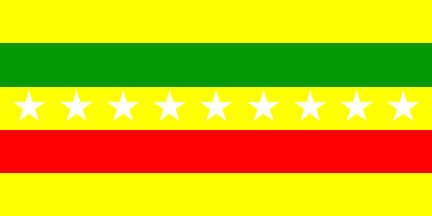 klaus-michael schneider
klaus-michael schneider
Keywords: el oro | zaruma |
Links: FOTW homepage | search | disclaimer and copyright | write us | mirrors

Last modified: 2021-08-26 by  klaus-michael schneider
klaus-michael schneider
Keywords: el oro | zaruma |
Links: FOTW homepage |
search |
disclaimer and copyright |
write us |
mirrors
 image by Ivan Sarajcic, 14 September 2007
image by Ivan Sarajcic, 14 September 2007
Parish:
See also:
At <www.cuencadeljubones.gov.ec>
there is a flag of five stripes: yellow-green-yellow-red-yellow,
with 9 white stars on the central yellow stripe. Same flag but
without the stars appears at <www.mipasaje.com>,
and the description say that there should be six stars in two
groups of three besides the coat of arms.
Dov Gutterman, 14 September 2007
The canton of Zaruma was formed on 26 November 1820. The place
was named after two Quechua words, "saramaiz" and
"uma", meaning together "maize cob". Due to
it resources in gold, the town was awarded in 1595 by King of
Spain Philip II the official name of "Villa Real de San
Antonio del Cerro de Oro de Zaruma" (Royal Town of St.
Anthony of the Gold Mountain of Zaruma).
Translated from <www.mipasaje.com>:
"Authors: Juan Francisco Ordoñez R. and Héctor A. Toro B.
The flag is made of three yellow stripes separated from each
other by a green stripe and a red stripe.
Yellow symbolizes the gold resources of the canton and the gold
filling the heart and spirit of the inhabitants. Green symbolizes
the abundant vegetation and the hope in the conquest of a happy
and great future through fraternity, work and culture. Red
symbolizes the never denied loyalty of the inhabitants towards
the Ecuadorian homeland, the civic fire burning in their veins
and their love of liberty, courage, science and beauty.
In the center, in the middle of six white stars, three on each
side, is placed the coat of arms of Zaruma, on a blue field, the
colour of the sky, the six stars representing the six rural
parishes forming the canton.
The flag shall be 2.50 m in length and 1.40 in width, with the
stripes as follows: the upper yellow stripe, 20 cm; the green
stripe, 30 com; the central yellow stripe, charged with the coat
of arms and the stars; 40 cm; the red stripe: 30 cm, and the
lower yellow stripe, 20 cm."
The coat of arms is described as follows (same source as for the
flag):
"Author: José Joaquin Palacios
The shield is divided in three quartered. Dexter or with a
representation of apart of the town of Zaruma with the elegant
tower of the church of the mother parish, surrounded by a few
houses, corresponding to the western part of the town and the
road to Castillo and Portovelo. In base a part of the mining
resources of Portovelo, with the steelworks and mills where the
gold-bearing quartz is triturated. In this part are also
represented the entrance of a mine and the Yellow River running
near the concession. The field is gold to symbolize the gold
resource of the region, the origin of the name of the province.
The sinister part of the shield is divided into two quarters,
argent (top) and gules (bottom). On the quarter argent are
represented the symbols of the independence of Zaruma, a Phrygian
cap (a classic symbol of liberty) and crossed, the mining tools:
two miner's picks and a steel "comba", and a garb of
rice, the main crop and staple food of the canton. These symbols
are placed on a field argent because of their constant relation
with mercantile transactions, the shield is also crowned by
Mercury's caduceus, emblem of trade and concord. On the gules
quarter, heraldically symbolizing love, liberty, passion and
loyalty, that is the greatest virtues of the human heart, is
placed a cornucopia or, filled with tropical flowers and fruits,
representing the agricultural resources of the canton.
Under the shield is placed a red scroll bearing the date of
independence of Zaruma, 26 November 1820"
Ivan Sache, 4 October 2008